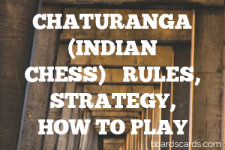Chinese Checkers: Mastering the Game with Rules, Instructions & Winning Strategies
Introduction
Chinese checkers, despite its name, is not a game that originated from China. Instead, it was developed in Germany in the late 19th century. The game is a variant of Halma (a game I’ve also written a guide on), which is a traditional American game. Chinese checkers is a strategy board game that can be played by two, three, four, or six people. The game is played on a star-shaped board with 121 holes. Each player has ten pegs or marbles that are placed in one of the six points of the star. The objective of the game is to be the first to move all your pieces from your home point to the opposite point on the board.

Chinese checkers is a strategy board game that can be played by two to six people, making it a versatile game suitable for small to larger groups. This flexibility in the number of players adds a layer of complexity and unpredictability to the game, as each additional player alters the dynamics of the game.
Chinese checkers, I find, is not just a game of luck, but a game of strategy. Players must think several moves ahead, anticipate their opponents’ moves, and adjust their strategy accordingly to win.
Rules for playing Chinese Checkers
The rules of Chinese checkers are simple and straightforward, making it a game that can be enjoyed by people of all ages. Here are the basic rules:
- Each player chooses a color and sets up their 10 pegs in their home point.
- Players take turns moving one of their pieces. A move consists of either moving a piece to an adjacent hole or hopping over another piece.
- Pieces can hop over any other piece, regardless of color, and can make multiple hops in a single move.
- Pieces cannot end their move in their own home point.
- The game ends when one player has moved all their pieces to the opposite point. That player is declared the winner.
While these are the official rules, many people play with ‘house rules’ that can add variations and additional challenges to Chinese Checkers.
The official rules of Chinese Checkers are quite straightforward. Up to six players can play, each with ten marbles of a different color. The objective is to get all your marbles to the opposite side of the board before any other player does. You can move your marbles to an adjacent space or hop over other marbles in any direction.
However, these rules can sometimes be adjusted by players to add more excitement and complexity to the game. House rules are unique variations of the official rules that are agreed upon by all players before the game begins. They can range from simple changes such as adding a timer to increase the pressure, to more complex variations like introducing new movement mechanics or altering the win conditions.
For example, some house rules may allow ‘double jumps’ – a move where you can jump over two adjacent marbles instead of just one. Others might introduce a rule where you can only move backwards if you’re in the lead, adding a strategic element to the game.
Other house rules might introduce penalties for certain actions, like losing a turn if you hop over your own marble. This can add an additional layer of strategy to the game, as players need to consider not just their own moves, but also how they might potentially benefit or hinder their opponents.
Additionally, house rules can also change the scoring system. Instead of just focusing on being the first to get all marbles to the other side, points can be awarded based on the number of marbles moved, the number of opponent marbles jumped over, or the number of marbles in the home triangle at the end of the game.
How to Win at Chinese Checkers
Winning at Chinese checkers requires a combination of strategy and skill. Here are some tips and strategies that can help you win:
- Plan your moves: Before making a move, consider all your options. Look for opportunities to make multiple hops and try to anticipate your opponent’s moves.
- Block your opponents: If possible, try to block your opponents’ paths. This can slow them down and give you an advantage.
- Use all your pieces: Don’t focus on moving just one piece at a time. Instead, try to move all your pieces as a group. This can help you create more opportunities for multiple hops.
- Stay flexible: While it’s important to have a strategy, be ready to adapt if things don’t go as planned. If your path is blocked, look for alternative routes.
Remember, practice makes perfect. The more you play, the better you’ll get at spotting opportunities and avoiding pitfalls.
Best Strategies for playing Chinese Checkers game
While there are many strategies for playing Chinese checkers, here are some of the best ones to consider:
- Center Control: Try to control the center of the board. This gives you more options for moving your pieces and can make it harder for your opponents to get past you.
- Chain Hopping: Try to set up your pieces so that you can make multiple hops in a single move. This can help you move your pieces across the board more quickly.
- Blocking: If you can’t make a move that advances your own pieces, consider making a move that blocks your opponents. This can slow them down and give you an advantage.
Here are some general gameplay strategies for Chinese checkers
Plan Ahead: Chinese Checkers is a game of strategy and planning. It’s essential to think multiple moves ahead. Try to anticipate how your opponent may react to your moves so you can counter it.
Use Blockades: Blockades can be formed by placing two or more pieces next to each other. These blockades make it difficult for your opponents to move their pieces. However, be careful not to block your own pieces.
Centralize Your Pieces: The center of the board is the best place to be in Chinese Checkers. It provides the most options for movement. Try to keep your pieces consolidated in the center of the board.
Jump Strategically: Jumps are an essential part of Chinese Checkers. You can jump over your own pieces and your opponents’ pieces. A good strategy is to line up your pieces so you can make multiple jumps in one move.
Use All Your Pieces: Try not to focus on moving just one or two pieces to the other side of the board. It’s more effective to move all your pieces together as a group.
Keep Your Pieces Together: If you can keep your pieces together in a block, you can move across the board more quickly. This strategy can also help protect your pieces from being jumped over by your opponents.
Utilize Your Opponent’s Pieces: You can jump over your opponent’s pieces to move across the board faster. Look for opportunities where you can use your opponent’s pieces to your advantage.
Be Adaptable: A good player must be adaptable. If your strategy isn’t working, don’t be afraid to change it up.
Practice: The more you play Chinese Checkers, the better you’ll get at it. Practice will help you understand the game better and develop effective strategies.
Keep an Eye on Your Opponent: Always keep an eye on your opponent’s moves. Try to anticipate their strategy and plan your moves accordingly.
Remember, the objective of the game is to be the first to move all your pieces across the board. Keep this goal in mind as you plan your moves and strategies.
Scenarios for Chinese Checkers
There are many different scenarios that can occur in a game of Chinese checkers. Here are some common ones and how to handle them:
- You’re blocked: If your path is blocked by your opponent’s pieces, look for alternative routes. You can also try to set up a chain hop to get past the block.
- You’re far behind: If you’re far behind your opponents, don’t give up. Look for opportunities to make multiple hops and try to block your opponents’ paths.
- You’re in the lead: If you’re in the lead, be careful not to get complacent. Keep moving your pieces as a group and try to block your opponents’ paths.
Frequently Asked Questions about playing Chinese Checkers
Q: Can I move my piece back into my home point?
A: No, once a piece has left your home point, it cannot return.
Q: Can I hop over my own pieces?
A: Yes, you can hop over any piece, regardless of color.
Q: Can I move a piece if it’s in the destination point?
A: No, once a piece has reached the destination point, it cannot be moved.
Q: What happens if all possible moves are blocked?
A: If all possible moves are blocked, the player whose turn it is must pass.
Q: Can I hop over multiple pieces in a single move?
A: Yes, as long as each hop is over an adjacent piece and lands in an empty hole.
External Links
Play Chinese checkers for free online (no registration) at NovelGames here.

A digital native around since the early days of online gaming communities around 2001. An early contributor to the cult gaming site ClanTemplates, Adam has spent years giving free gaming resources to the community. With BoardCards, Adam is most experienced and commonly writing the articles on Strategy multi-player games like Settlers of Catan and Avalon. His first introduction to board games was via Mancala, an Egyptian-origin stone game and one of the oldest known games still played worldwide. Contact me via email



